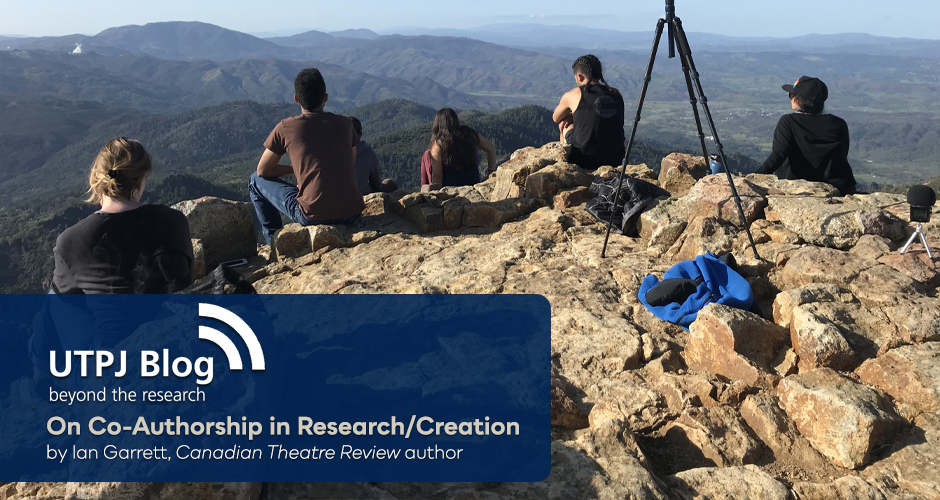
Groundworks collaborators take a seat on Mount St. Helena / Kanamota
Featured (L to R): Sophie Traub, Michael Jaguar, Desirae Harp, Kenny Ray Ramos, Tiśina Parker
Photo Credit: Ian Garrett
Written by guest blogger Ian Garrett.
Research/Creation, in which the creative process is a key research methodology, is an essential part of my own research and what feels like the work of a growing number of scholars. It is also finding more institutional support. At my own institution, York University, there is a “Complex Electronic and Multimodal” Theses and Dissertation option for Masters and Doctoral programs, which specifically points to artworks or theatrical productions as potential elements of a these or dissertation alongside a written component. However, even the description highlights challenges to supporting these options. Students are advised to consult with the Library and Archives Canada to determine what formats work for preservation. This highlights just one of the challenges that comes up when trying to fit Research/Creation into our typical modes of research.
Additional hurdles to fit in our institutional frameworks do not end with the submission of the thesis or dissertation. This also come up within publishing. In particular, this is true in determining how to document authorship of a collaborative process. Many publishers look to substantial contributions to the writing of a piece to determine if someone should be listed as an author. I give credit to many publishers who are generous with their thinking about how to be more inclusive about these contributions. Contribution does not always mean the writing itself, but often includes a critical discourse around the article.
For example, my recent contribution to Canadian Theatre Review regarding the investigation into using augmented reality for Deaf and ASL interpretation engaged through Theatre Passe Muraille’s Accessibility Labs offers an interesting discussion around contribution. While I did most of the preparation for that publication for the article in terms of the practical coordination and writing for Journal publication, there is no project and the research is not rigorous without the collaborators on the project itself. I feel that all contributors to the project in the theatre are authors, in one way or another, contributing to this article. But this might not always cross the threshold regarding the basis by which a publication determines authorship. In this instance we had a discussion about who had a hand in the preparation of the article directly through ongoing conversations, reviewing drafts, and making suggestions to the text. This documented impact on the final form of the article itself established an agreed authorship. All contributors were then also attributed in the back matter of the article as well to make sure all labour was visible.
I have also worked this way on a forthcoming chapter on a project called Groundworks–a collaboration on site-specific performance media with indigenous artists in Northern California–in the Routledge Handbook on Digital Environmental Humanities, which will be out in Fall 2022. Similarly, it was a conversation between authors, editors, and publishers about what authorship means in articles that serve as outputs from Research/Creation projects. One difference in the publishing of that chapter was that at the outset of the project we had established agreements in the project which specified share authorship. These agreements were originally meant to devolve the rights of our shared data back to the artists and their communities, but also assumed there may be publishing in the future and foresaw the need for shared authorship. This forethought led to more than written scholarship, but also established deep trust through transparency and respect of multiple knowledge systems.
Neither of these were straightforward, and I’m grateful to work with editors and publishers for being willing to work with me and my collaborators to respect our community agreements in the publishing process. Like with the challenges of supporting diverse research/creation approaches to a thesis or dissertation, proper crediting and authorship in collaboration deserves time and consideration so that we may respect research contributions that might not fit within the assumptions of our western institutional frameworks.
About the Author
Ian Garrett is a designer, producer, educator, and researcher in the field of sustainability in arts and culture. He is the director of the Centre for Sustainable Practice in the Arts and Associate Professor of Ecological Design for Performance at York University, where he is Graduate Program Director for Theatre and Performance Studies. He is also producer for Toasterlab, a mixed reality performance collective. He maintains a design practice focused on ecology, accessible technologies and scenography.
His feature, “Augmented Reality ASL for 11:11 at Theatre Passe Muraille” appears in Canadian Theatre Review volume 190.
Comments on this entry are closed.